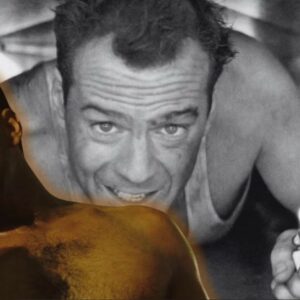Quentin Tarantino’s Pulp Fiction remains a seminal work in cinema history, known for its innovative storytelling, sharp dialogue, and eclectic characters. Among its ensemble cast, Bruce Willis’s portrayal of Butch Coolidge stands out as a particularly memorable and complex role. As a boxer entangled in a series of precarious situations, Willis’s performance was marked by unique challenges and behind-the-scenes struggles that contributed to the film’s success. This article delves into the multifaceted difficulties Bruce Willis faced while bringing Butch Coolidge to life, shedding light on the intricate process that went into creating one of Pulp Fiction‘s most enduring characters.
1. Navigating Tarantino’s Unconventional Directorial Style
Quentin Tarantino’s directorial approach is widely recognized for its distinctiveness, characterized by his unorthodox methods and emphasis on dialogue-driven storytelling. For actors, this means adapting to a style that often deviates from traditional filmmaking norms. Bruce Willis, known for his work in action films and mainstream dramas, had to navigate Tarantino’s unique directorial vision, which included:
- Dialogue-Heavy Scenes: Tarantino’s script is renowned for its sharp, verbose dialogue. Willis had to immerse himself in a script that demanded not only emotional depth but also a mastery of the rhythm and nuance of Tarantino’s dialogue. This was a departure from the more action-oriented scripts Willis was accustomed to, requiring him to focus heavily on verbal performance and timing.
- Non-Linear Storytelling: Pulp Fiction is famous for its non-linear narrative structure, which means that scenes are not shot in chronological order. Willis had to manage his performance across a fragmented timeline, maintaining continuity and depth in a role that spanned various emotional states and plot developments.
- Embracing Tarantino’s Vision: Tarantino’s creative vision often involves pushing boundaries and embracing unconventional elements. Willis had to adapt to a directing style that emphasized creativity over convention, requiring him to embrace the unpredictability and eclectic nature of Tarantino’s approach.
2. The Physical Demands of the Role
Butch Coolidge is a character whose physical presence is as significant as his emotional depth. For Bruce Willis, this meant enduring several physical challenges to convincingly portray a boxer caught in a whirlwind of danger and conflict:
- Training and Conditioning: To convincingly portray a boxer, Willis had to undergo rigorous physical training. This included boxing workouts, conditioning, and choreography to ensure that his movements and physicality matched the character’s background. The physical training was demanding and required Willis to maintain a high level of fitness throughout the filming process.
- Fight Choreography: One of the film’s most iconic scenes involves a brutal fight between Butch and his opponent. Willis had to work closely with stunt coordinators and fight choreographers to ensure that the fight scenes were both realistic and safe. The choreography had to reflect the intensity of a real boxing match while adhering to the safety protocols of film production.
- Endurance and Injury: The physicality of the role also meant that Willis had to deal with the potential for injuries. The demanding fight scenes and physical stunts carried a risk of injury, which Willis had to manage carefully to avoid setbacks that could impact the filming schedule.
3. The Emotional Complexity of the Character
Butch Coolidge is a character with considerable emotional depth, and portraying him required Bruce Willis to delve into complex psychological terrain:
- Internal Conflict: Butch is a character driven by a mix of survival instincts, moral dilemmas, and personal vendettas. Willis had to convey Butch’s internal struggle with authenticity, portraying a man grappling with the consequences of his choices and the challenges he faces. This required a nuanced performance that went beyond superficial characterization.
- Emotional Range: Throughout the film, Butch experiences a wide range of emotions, from desperation to defiance. Willis had to tap into this emotional spectrum, delivering a performance that was both raw and relatable. Balancing these emotional shifts while maintaining continuity in his portrayal was a significant challenge.
- Character Development: Butch’s journey involves significant development, from a boxer on the run to a man confronting his own mortality. Willis had to navigate this character arc, ensuring that Butch’s evolution was believable and compelling. This required a deep understanding of the character’s motivations and a commitment to portraying his growth throughout the film.
4. Interacting with a Diverse Ensemble Cast
Pulp Fiction features an eclectic ensemble cast, and Bruce Willis’s interactions with his co-stars added another layer of complexity to his performance:
- Chemistry with Co-Stars: Willis’s role involved key interactions with characters played by John Travolta, Uma Thurman, and Ving Rhames, among others. Building on-screen chemistry with such a diverse group of actors required adaptability and collaboration. Willis had to seamlessly integrate his performance with those of his co-stars, ensuring that his character’s interactions were authentic and engaging.
- Tension and Dynamics: The film’s unique narrative structure means that characters often intersect in unexpected ways. Willis had to navigate these intersecting storylines, ensuring that his interactions with other characters felt natural and aligned with the film’s overall tone.
- Balancing Screen Time: With an ensemble cast, screen time is often distributed among multiple characters. Willis had to manage his performance in a way that complemented the film’s broader narrative while ensuring that Butch Coolidge remained a compelling and integral part of the story.
5. Working with Tarantino’s Script Changes
Tarantino is known for making adjustments to scripts even during filming, which can create additional challenges for actors:
- Adaptability: Bruce Willis had to remain flexible and adaptable as Tarantino made changes to the script. This required quick adjustments to lines, scenes, and character dynamics, ensuring that Willis’s performance remained consistent with the evolving vision of the film.
- Consistency: Maintaining character consistency amidst script changes was crucial. Willis had to ensure that Butch’s portrayal remained coherent and true to the character’s essence, even as the script evolved.
- Collaborative Process: Willis had to collaborate closely with Tarantino and the rest of the cast to accommodate script changes. This collaborative process involved open communication and a willingness to embrace the fluid nature of Tarantino’s creative process.
6. The Impact of Pulp Fiction on Bruce Willis’s Career
The challenges Willis faced while filming Pulp Fiction had a lasting impact on his career, influencing his subsequent work and public perception:
- Career Diversification: Pulp Fiction showcased Willis’s versatility as an actor, demonstrating his ability to handle complex, multifaceted roles beyond his usual action-hero persona. This helped diversify his career and opened doors to a broader range of roles in different genres.
- Critical Acclaim: Willis’s performance in Pulp Fiction received critical acclaim, contributing to his reputation as a skilled and versatile actor. The role of Butch Coolidge remains one of the highlights of his career, reflecting his ability to tackle challenging and unconventional characters.
- Legacy and Influence: The success of Pulp Fiction cemented Willis’s place in cinematic history and demonstrated the impact of embracing unconventional roles and working with visionary directors. It influenced his approach to subsequent projects and his willingness to take on diverse and challenging roles.
Conclusion
Bruce Willis’s portrayal of Butch Coolidge in Pulp Fiction stands as a testament to his adaptability, dedication, and skill as an actor. The unique struggles he faced—ranging from navigating Quentin Tarantino’s unconventional directorial style to enduring physical demands and emotional complexities—highlight the intricate process behind creating an iconic character. Willis’s performance not only contributed to the film’s critical acclaim but also marked a pivotal moment in his career, showcasing his ability to embrace complex roles and collaborate with visionary filmmakers. As Pulp Fiction continues to be celebrated as a groundbreaking film, Bruce Willis’s role as Butch Coolidge remains a defining and memorable contribution to its enduring legacy.





